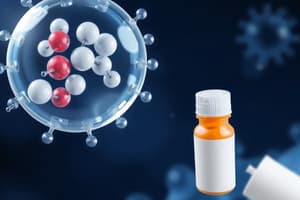Podcast
Questions and Answers
What is the principle of superposition?
What is the principle of superposition?
- The principle that states that pulses can never interact with each other.
- The principle that states that pulses can only travel in one direction.
- The principle that states that the resulting disturbance is the sum of the individual disturbances from each pulse. (correct)
- The principle that states that pulses can only interact with each other at their endpoints.
What happens to the amplitude of each pulse after they interact with each other?
What happens to the amplitude of each pulse after they interact with each other?
- The amplitude of each pulse is reduced to zero.
- The amplitude of each pulse is doubled.
- The amplitude of each pulse is halved.
- The amplitude of each pulse remains unchanged. (correct)
What is the result of constructive interference?
What is the result of constructive interference?
- A pulse with a larger amplitude. (correct)
- A pulse with a smaller amplitude.
- A pulse with a negative amplitude.
- A pulse with a zero amplitude.
What is the result of destructive interference?
What is the result of destructive interference?
What happens when a crest of one pulse meets the trough of another?
What happens when a crest of one pulse meets the trough of another?
What is the correct definition of destructive interference?
What is the correct definition of destructive interference?
What is the correct definition of constructive interference?
What is the correct definition of constructive interference?
What is true about the pulses after they interact with each other?
What is true about the pulses after they interact with each other?
What is the primary condition for the principle of superposition to apply?
What is the primary condition for the principle of superposition to apply?
Which type of interference occurs when a crest of one pulse meets a trough of another?
Which type of interference occurs when a crest of one pulse meets a trough of another?
What happens to the resulting pulse when two pulses with opposite phases meet?
What happens to the resulting pulse when two pulses with opposite phases meet?
What is the effect of constructive interference on the amplitude of the resulting pulse?
What is the effect of constructive interference on the amplitude of the resulting pulse?
What is the net effect on the pulses after they interact with each other?
What is the net effect on the pulses after they interact with each other?
What is the purpose of visualizing superposition?
What is the purpose of visualizing superposition?
When do two pulses interact with each other?
When do two pulses interact with each other?
What is the result of the interaction between two pulses with the same phase?
What is the result of the interaction between two pulses with the same phase?
When do two pulses exhibit destructive interference?
When do two pulses exhibit destructive interference?
What is the sum of the individual disturbances from each pulse according to the principle of superposition?
What is the sum of the individual disturbances from each pulse according to the principle of superposition?
What happens when two pulses with the same phase meet?
What happens when two pulses with the same phase meet?
What is the purpose of the principle of superposition?
What is the purpose of the principle of superposition?
What is the characteristic of the resulting pulse after constructive interference?
What is the characteristic of the resulting pulse after constructive interference?
What is a requirement for the principle of superposition to apply?
What is a requirement for the principle of superposition to apply?
What is the effect of destructive interference on the amplitude of the resulting pulse?
What is the effect of destructive interference on the amplitude of the resulting pulse?
What is the relationship between the resulting pulse and the individual pulses after they interact?
What is the relationship between the resulting pulse and the individual pulses after they interact?
What is the primary principle that governs the interaction between two or more pulses traveling through the same medium?
What is the primary principle that governs the interaction between two or more pulses traveling through the same medium?
What happens when a pulse with a large amplitude meets a pulse with a small amplitude, resulting in destructive interference?
What happens when a pulse with a large amplitude meets a pulse with a small amplitude, resulting in destructive interference?
What is the characteristic of the resulting pulse when two pulses with the same phase meet and undergo constructive interference?
What is the characteristic of the resulting pulse when two pulses with the same phase meet and undergo constructive interference?
What is the requirement for the principle of superposition to apply to two pulses?
What is the requirement for the principle of superposition to apply to two pulses?
What is the net effect on the pulses after they interact with each other and undergo constructive interference?
What is the net effect on the pulses after they interact with each other and undergo constructive interference?
What is the visual representation of the interaction between two pulses?
What is the visual representation of the interaction between two pulses?
What is the primary reason why two pulses with opposite phases exhibit destructive interference?
What is the primary reason why two pulses with opposite phases exhibit destructive interference?
What is the result of the interaction between two pulses with the same amplitude but opposite phases?
What is the result of the interaction between two pulses with the same amplitude but opposite phases?
What happens when the crests of two pulses coincide?
What happens when the crests of two pulses coincide?
What is the characteristic of the pulses after they interact with each other?
What is the characteristic of the pulses after they interact with each other?
What type of interference occurs when a pulse meets another pulse with an opposite phase?
What type of interference occurs when a pulse meets another pulse with an opposite phase?
What is the purpose of visualizing superposition?
What is the purpose of visualizing superposition?
What is the condition for two or more pulses to interact with each other?
What is the condition for two or more pulses to interact with each other?




